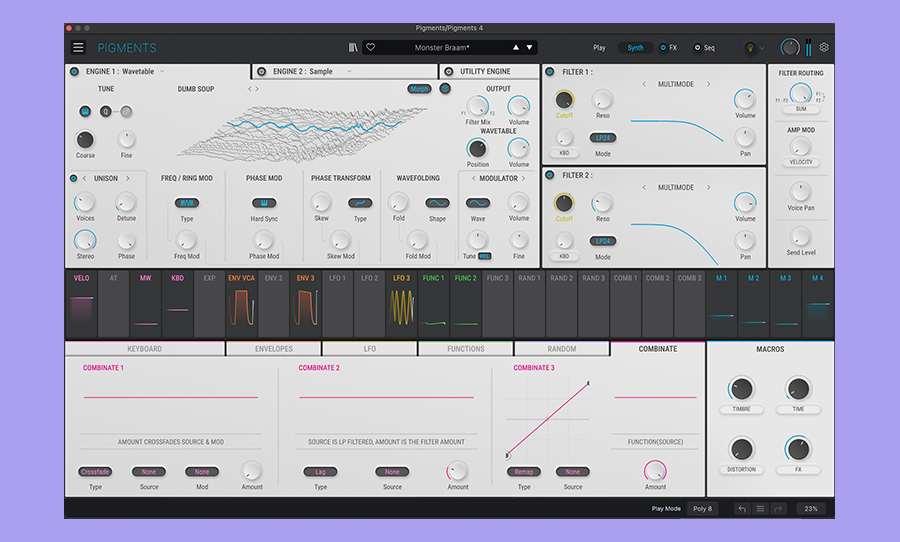Be ready to start a musical journey as Arturia has done it again with Pigments 4: a highly creative and intuitive polychrome software synthesizer.
Arturia’s latest update to Pigments — Pigments 4 — sees them give the interface a refreshing overhaul, a new and simplified ‘Play’ view, a drag and drop workflow, a new factory bank and sound banks, and up-to-date tutorials — although, it’s a software synth that you can dive into very easily and create instantly. And if you own Pigments already, this is a free update.
For those of you new to Pigments, it’s a polychrome software synthesizer, unlike their incredible emulations, it stands alone as a beast of an instrument with a stylish layout that leaves all its complexity away from the user. And thank goodness for that.

Maybe it’s the inclusion of the new Play mode that brings everything clearly to the front and makes the interface easier to navigate. Everything being: Engine 1, Engine 2, the Utility Engine, the two Filters, FX A and B and the AUX Send, the stunning waveform display in the middle that moves between views, the keyboard, the Amplitude Envelope and four Macros.
What Arturia devotees might find pleasing if they are new to the Pigments range is that you can use Filters from their recreations like the Matrix 12 and the MS-20 (this is a new addition) and The SEM plus many more. You can also use effects from their FX Collection 3 like the Chorus JUN-6 and the BL-20. New reverb alert too, Shimmer Reverb. It’s got 2 octaves of pitch shift and built-in modulation inside a stunning cathedral-like reverb.

Getting out of the pleasing, but simple Play mode, synth lords will be pleased with the new drag-and-drop workflow — it’s very easy to send a modulation source to its destination and adjust the depth by hovering over the parameter. It’s this type of workflow where we’re noticing more and more that companies like Arturia are listening to the people and making their software more and more intuitive.
Speaking of that, Arturia has updated the theme to offer light mode as well as its classic dark mode. And for those that find some of Arturia’s emulation of modular synths overwhelming, Pigments 4 feels like a much easier interface to move around without the questions of ‘how did I do that?’. For example, it’s much easier to bypass the FX in the Synth and new Play modes.

There’s new sync modes so you can get create some rhythmic ideas you may have never thought about — finding spaces between straight, triplet and dotted rhythms, and speaking of going in between, Pigments 4 is now compatible with ODDSound’s micro tuning software MTS-ESP, designed in conjunction with Aphex Twin.
The engines have been enhanced too, the Wavetable engine has a new Ring Mod feature and Phase Transformation section. The Harmonic Engine — which I personally think has the coolest graphics ever with a cross between a lie detector test and an old studio console X and Y display — has new harmonic discoveries for you and pitch variations. The Modulator Oscillator now has an extended hertz range from 0.100 to 20,000 — deep diving ahead!

Hitting up one of the 63 new wavetables I chose ‘Dumb Soup’ and it killed with its crunchy goodness and I added even more vibe when I automated the Wavetable position. Moving over to the sample engine I loaded up one of the 67 new samples — I wanted to see what the new 808 samples could do. Very impressed. I added some noise to it as well to give the sound some tops — there’s 36 new noise types to choose from btw. And for those that didn’t know, you can load up and edit your own samples too.
On top of all this, there’s now more Unison options — you can control unison in all the engines and there’s unison phase control for Wavetable and Sample voices. As well as this there’s a new effect —Super Unison. It’ll give you ultra-wide ensemble timbres with its 8 voices and stereo-width control.
If all this wasn’t enough, there’s 3 new sound banks Wavelengths Lo-fi, Wavelengths Neuro Bass and Wavelengths Cinematic. Think retro lo-fi beats, colossal basses (farewell to your speakers), and ambient sounds that will make Brian Eno intrigued. Each bank has 150 presets for you to explore.

Pigments 4 is a synth and sound playground, not to mention that its now much more intuitive — with the ability to make the GUI simple with Play more or complex by diving into all the windows and controls.
Arturia’s Pigments 4 is available from their website, Arturia.com



